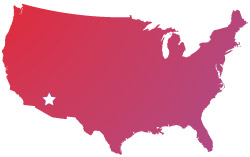True Grit
Sure, Arizona has the Grand Canyon and all, but it also has some pretty great cities. Think you know all there is to know about Phoenix? Here are a few things you may not have realized about Phoenix and its residents, called Phoenicians:
- Talk about ancient ingenuity! For more than 1,000 years (A.D. 600-1450) the Hohokam people inhabited the area that is now called Phoenix. The Hohokam built over 135 miles of irrigation canals snaking from the Gila and Salt rivers, making the desert livable. The majority of the remains of these ancient canals lies underneath the streets of metropolitan Phoenix, and some are still in use today.
- The geographical area of Phoenix and surrounding cities is known as "The Valley of the Sun." Mountains surround the Phoenix metro area, while the city itself, with the exception of some good hiking peaks dotted throughout the town, is fairly flat. Dust bowl? Maybe. But the surrounding mountain ranges provide some shelter from extreme winds. Too bad they don't help with the heat.
- The Valley of the Sun still holds true to the grit of its scofflaw Old West history. Phoenix (and most of Arizona) does not participate in Daylight Saving Time. The city refuses to turn clocks forward or back. The Navajo Nation, located in the northeastern part of the state, is the only area that follows DST. Phoenicians like to do things their way.
- The land that was purchased to establish the modern Phoenix area (320 acres of it) was purchased for $550—all in gold coin. What is that amount in today's dollars? About $35,000. Real estate magnates that hover over the city these days would kill for that deal.
- Phoenix wasn't originally the capital of Arizona. In the Arizona Territorial days, Prescott (about 1.5 hours north of Phoenix) was the area's hub. Bickering officials throughout the Territory vied for capital status; the title bounced to Tucson, back to Prescott, then finally settling in the Valley. Phoenix was officially named as the capital the same day Arizona was declared a state—February 14, 1912. We heart you, Phoenix.
- The construction of Phoenix's capitol building in began in 1898. Its domed roof is covered in lots of copper—the equivalent to 4,800,000 pennies! Officials in the Arizona Territory built the structure as an appeal to demonstrate that Arizona was ready to become a state. Guess it helped—statehood was granted in 1912.
- Tovrea Castle is a wedding-cake-shaped mansion perched atop a hill smack-dab in the middle of Phoenix. The original owners surrounded the house with hundreds of saguaro cactus: a castle moat, Arizona-style. Even though the city of Phoenix purchased the property in 1993, no successful efforts have been made to restore it and open it for tours.
- At 17,000 acres, South Mountain Park in Phoenix is the largest city park in the world. It's not your traditional "park," with ponds and playgrounds on carefully tended lawns. It's a desert mountain preserve, with 58 miles of trails for hiking, mountain biking and horseback riding. Desert critters live here, too: watch for snakes and bunnies! Non-hikers can take a scenic drive along South Mountain-s paved roads—no hiking shoes necessary.
- Papago Park sits at the edge of Phoenix and has a history as old as the rocky hills inside its boundaries. The Hohokam people used the giant Hole in the Rock (one of the park's older-than-dirt geological formations and a main attraction for hikers) to keep track of the seasons. The area was used first as a reservation for the Maricopa and Pima tribes, and then as a World War II POW camp. The park now enjoys a quieter, less volatile status: hiking, biking and climbing.
- The Phoenix area is known for the "Five Cs" of commerce in the state: Cattle, Copper, Citrus, Climate and Cotton. Sixty percent of the nation's copper comes from Arizona mines (we're not counting the stuff on the capitol building's dome); top-quality Pima cotton is grown within city limits; and beef from Arizona's ranches is shipped as far away as Japan. Phoenix's dry, sunny climate is perfect for growing citrus, which are shipped all over the country. The last "C," climate, is a reference to the tourist industry and the cash it brings to the city.

||Tag: ||